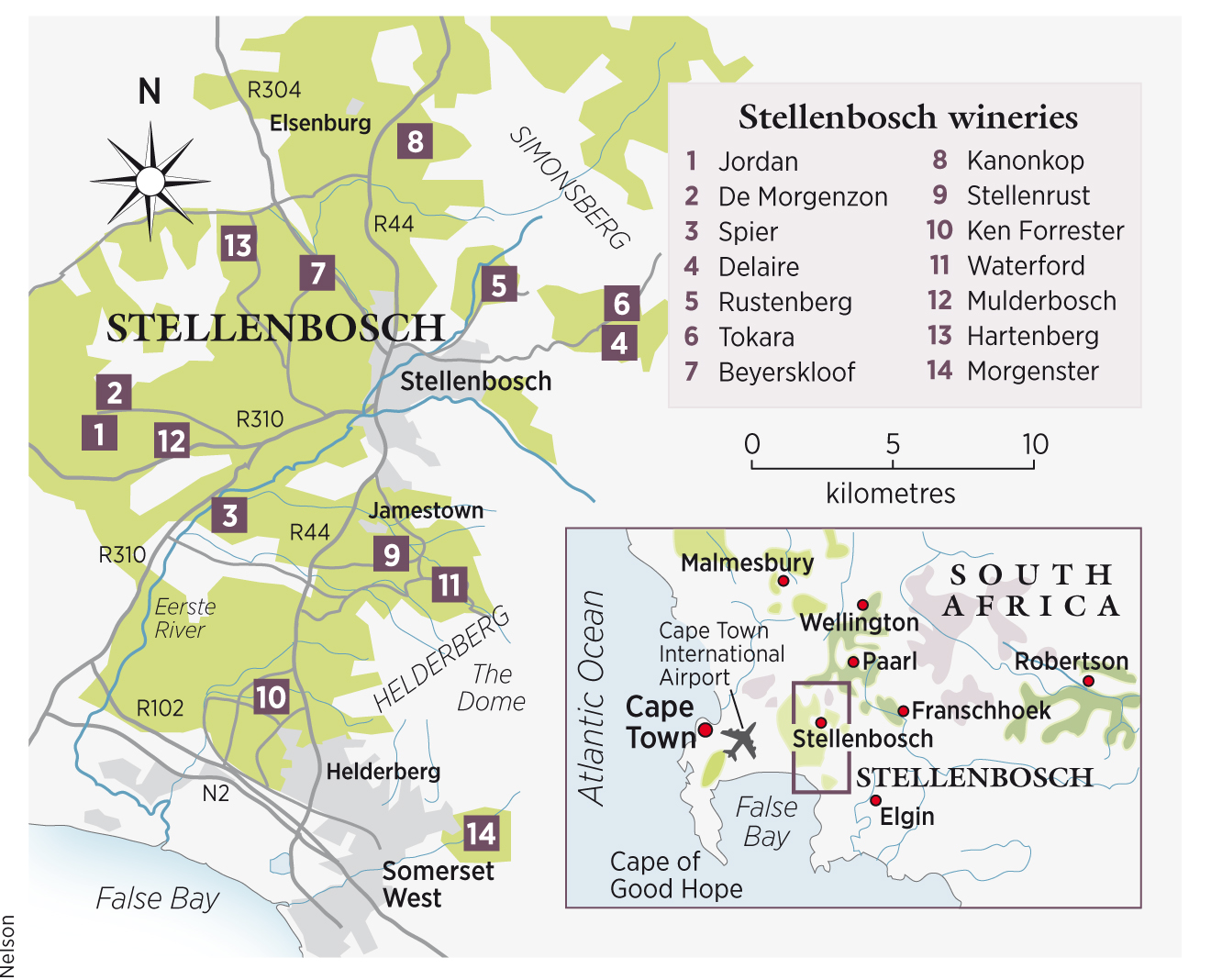Bustling with vineyards, heritage architecture, art and plenty of opportunities for outdoor dining, Angela Lloyd gives the low-down on why this region really is a destination for all seasons. Read her Stellenbosch travel guide.

Towering mountains linked to a chain of commanding hills; both guard an amphitheatre of undulating, vineyard-covered foothills and valleys, all leading to a vivid green-blue sea. Such is the dramatic beauty of the Stellenbosch winelands, even locals never tire of it, let alone the first-time visitor. But Stellenbosch is about much more than jaw-dropping vistas – it’s a region for all seasons, all wine styles and more besides. It’s a region that can be traversed within an hour, though incurious indeed would be the traveller who would not want to dally and explore all it has to offer.The original settlement on the banks of the Eerste river (First river) was founded by then Governor of the Cape, Simon van der Stel in 1679. Vineyards were planted shortly after that, making Stellenbosch the second-oldest wine region in South Africa after Constantia.
Quick links:
Culture and wine
Nowadays, Stellenbosch is a bustling university town, about an hour’s drive from Cape Town. Besides shops and restaurants aplenty, Cape Dutch national heritage houses (particularly in oaked- lined Dorp Street) are worth leisurely admiration.Those who love the arts are well catered for. Several galleries house contemporary and historic art, and several wine farms have exhibitions, too. If your interest extends to see how it’s done, visits to well-known local sculptor Dylan Lewis’ studio can be arranged. His works may be found in gardens of wine farms such as Delaire Graff.
For music enthusiasts, both classical and jazz concerts are staged throughout the year at Endler Hall. In summer, the outdoor Oude Libertas amphitheatre offers a programme of varying music genres, while in neighbouring township Kayamandi, AmaZink, a pulsating musical and dining experience, is not to be missed.
But wine is the main story here. The vineyards, fanning out from the town, are home to the greatest number of wineries of any area, currently about 160, featuring both large and small operations. The former includes the country’s largest wine and spirits producer, Distell (distell.co.za) behind such wine brands as Nederberg, Pongracz, Stellenzicht and Lomond.
Making a choice from this daunting figure is eased by the Stellenbosch wine tourism body’s informative booklet and internet guide (wineroute.co.za), where member wineries have been divided into five sub-routes to make organising cellar door visits simpler. This is all a far cry from 1971, when the Cape’s first wine route was founded in Stellenbosch with just a handful of members.
Winery architecture here is as diverse as the wines – from the whitewashed low walls and traditional gabled manor house at Rustenberg (rustenberg.co.za) to the strikingly modern cellar at Tokara (tokara.com). Both wineries produce a typical, quality range of white and red wines, including the area’s signature variety, Cabernet Sauvignon.
Grape varieties galore
If Cabernet is acknowledged as king, home-bred Pinotage (often maligned outside South Africa) has some of its most ardent fans in Stellenbosch, with Beyers Truter leading the pack. At his Beyerskloof wine farm (beyerskloof.co.za) the grape’s versatility is demonstrated in everything from rosé to a vintage Port-style, the latter with some Touriga.
Pinotage is also indelibly linked to Truter’s previous cellar at Kanonkop (kanonkop.co.za), where fruit from a venerable 50-year-old vineyard goes into the sumptuous Black Label Pinotage.
More old-vine concentration comes with Chenin Blanc from Stellenrust (stellenrust.co.za), also from vines older than 50 years, as well as bush-vine Cinsault – an ancient Cape variety enjoying renewed interest across the country; here Tertius Boshoff gives it the care it deserves.
But it is Chenin Blanc that still holds sway as the Cape’s most planted variety. Although much remains destined for brandy, an increasing number of winemakers have shaken up the variety’s former image as a cheap and cheerful glugger and are producing wonderfully complex, concentrated and ageworthy wines. Look for some excellent Chenin- led white blends too. Ken Forrester, fondly known as Mr Chenin (kenforresterwines.com) has done much to generate this newfound interest.
A popular way to discover more about the region’s gastronomic delights, wine and food pairings are a favourite at many wineries. Try wine and chocolate matching at Waterford (waterfordestate.co.za) or pairing wine with pizzas cooked in the wood- fired oven at Mulderbosch (mulderbosch.co.za).
Stellenbosch and its numerous wineries might cover a relatively small area, but the various aspects, altitudes, soils and proximity to the sea with its cooling effects, allow for many varieties to be grown successfully beyond Chenin, Cabernet and Pinotage. At Hartenberg (hartenbergestate.com), Carl Schultz produces two Rieslings as well as five individual Shirazes.
The varietal spread has also been encouraged by foreign investors who have bought and developed farms here. Giulio Bertrand planted his favourite native Italian varieties, Nebbiolo and Sangiovese, on his Morgenster estate (morgenster.co.za), as well as olive trees too – don’t miss his award- winning extra virgin oil. And long-time Italian expat Giorgio dalla Cia and son George (dallacia.com) distil their Pinot Noir, Chardonnay, Cabernet and Merlot into grappa-style spirits.
Summer and Autumn (between November and April) are the warmest, driest times to visit, with harvest a bonus, but winter and spring (May to October) also have their attractions. There are lots of sunny days between the rain to enjoy hiking, mountain biking, golf and visiting a few more of those 160 wine farms at this quieter time of year known as the Green Season. And if it does rain, there’s still all the shops and eateries that Stellenbosch town has to offer.
At the end of your trip, you’ll realise that one visit to this beautiful region is never enough.
How to get there
Direct flights via British Airways and Virgin Atlantic take about 11.5 hours to Cape Town International Airport. Stellenbosch is a 35km drive away.

Written by Angela Lloyd


